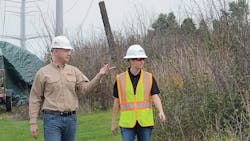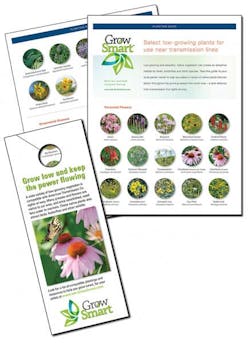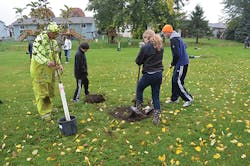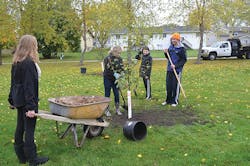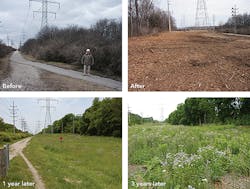Trees are an important part of a community’s landscape. When landowners receive news that a utility needs to prune branches or remove trees near power lines on their property or in their community, questions and public concern can be expected, especially since vegetation management standards have continued to evolve.
Prior to the 2001 formation of American Transmission Co. (ATC) as a transmission-only utility based in Waukesha, Wisconsin, U.S., thousands of miles of transmission line rights-of-way (ROW) were managed by several local distribution utilities, and landowners encountered varied types of vegetation clearing practices. Since then, transmission line vegetation maintenance practices have changed as a result of new policies.
To ensure compliance with the policies established by the Federal Energy Regulatory Commission, ATC staffed an internal vegetation management team of utility arborists to oversee a vegetation management program that follows the required ANSI A300 and Z133 standards. These standards are supplemented, where appropriate, with the International Society of Arboriculture’s Best Management Practices for Integrated Vegetation Management (IVM), which include multiple control methods to prevent vegetation encroachment within the ROW.
The goal of ATC’s vegetation management program is to maintain a five-year cycle on the ROW and to establish sustainable ROW. This type of ROW management has required ATC to enhance its communication with landowners throughout the entire process.
IVM is a road map to a successful vegetation management program; however, landowners can be unhappy with this, especially when it involves trees in the ROW and varied historical maintenance practices. While practices continue to evolve based on industry experience, making IVM clear to the landowners comes down to two paramount goals: public safety and electric system reliability.
Grow Low, Grow Smart
ATC and its contractors employ many skilled and qualified utility arborists who interact with landowners. Internally, ATC’s vegetation management, local relations and corporate communications teams collaborate on creating targeted educational materials for landowners in the form of letters, door hangers and other outreach efforts. These tools aid the contractors and the vegetation management team, providing key information to landowners about the critical nature of maintaining ROW clearance for public safety and electric system reliability.
To help increase landowner understanding and engagement in vegetation management activities, ATC developed a comprehensive outreach program that pairs vegetation management notification communications with information and resources about compatible plantings that minimize future risks to public safety and electric system reliability. The effort is to encourage landowners to grow smart near transmission infrastructure. ATC’s Grow Smart program sends a simple message: Trees and power lines are a dangerous combination, but growing low will help to keep the power flowing.
Grow Smart strives to educate the public about low-growing native vegetation that can be planted within transmission line ROW, providing food and habitat to birds and butterflies while encouraging the presence of pollinators in the ROW. Native plants and grasses with deep root systems also are promoted because of their resiliency; they can easily recover from utility maintenance work. In addition, sustainable ROW with native plant communities can help to reduce long-term vegetation management maintenance work.
“While the vast majority of landowners understand that ATC’s vegetation management work is necessary, occasionally some express concerns about the visual landscape after the trees are removed,” said Anne Spaltholz, ATC’s manager of corporate communications. “We wanted to be sure that we were doing all that we can to help landowners understand that there are some great options for beautifying the landscape following vegetation management work.”
ATC enlisted the help of Melinda Myers, a nationally renowned horticulturist, author and radio/TV host, to deliver Grow Smart messages through TV and radio advertising, online resources and videos, print materials and special appearances. “Partnering with a horticulturist such as Melinda helps to deliver our key messages about the importance of safety and reliability, while emphasizing that beautification under and near power lines still is possible,” Spaltholz explained.
TV commercials featuring Myers and the Grow Smart message kicked off in spring 2014 and continue in 2015. In a video on ATC’s Grow Smart website (www.atc-GrowSmart.com), Myers shows different types of compatible vegetation that can be grown near transmission lines. Site visitors also can download a planting guide that identifies and shows pictures of compatible plantings that visitors can take to a garden center.
Contractor Training
ATC provides monthly training to contract vegetation management crews to ensure they understand ATC’s vegetation management program objectives. Crews are also trained to communicate Grow Smart messages in their face-to-face interactions with landowners. Custom door hangers provide them with a tool to reinforce the Grow Smart messages with information about vegetation management practices, compatible plantings and where to find further information.
Prior to the contractor’s interaction with the landowners, ATC’s notification process includes letters to landowners about the need and timing of upcoming work, print materials and web resources with answers to commonly asked questions about current practices and guidelines, descriptions of line sag and blowout, safety clearances, easements and ROW access, herbicides, and what to expect after vegetation management work is complete. These tools reinforce the grow-low message to landowners in a consistent manner.
Local Relations Outreach
According to Mary Carpenter, a senior local relations representative, the Grow Smart message is beginning to resonate, particularly in urban areas. “The process of educating people about ROW vegetation management is challenging for any utility,” Carpenter commented. “Of course, there are state and federal standards that we are required to meet, but making sure that landowners understand why we need to prune and remove their trees — along with what they can replant — is completely different. Whether we clear vegetation under and near lines for cyclical vegetation management or for capital project rebuilds, we typically start months ahead with landowners in that communication process.”
The notification letters sent by local relations to landowners provide the project’s schedule and prompt the landowners to consider low-grow options if they are planning to do landscaping following the clearing work. “I include the Grow Smart planting guide in these notifications,” Carpenter said. “I also describe the program on the phone when talking with landowners about the work. Although people can be unhappy about losing their trees, the feedback I’ve gotten about this program is that residents are appreciative that we’re helping create alternatives for ROW growth, and they find this information helpful.”
ATC also is working with community organizations to ensure proper planting near transmission lines. Plans are underway with a suburban school to develop a low-growing, compatible landscape in the 138-kV ROW along the school property and community ballpark. In collaboration with a landscape architect, the plan will develop the entire ROW into a native prairie grassland and butterfly garden. In another suburban neighborhood, residents are partnering with ATC to create a vegetation plan and layout to restore the ROW, which has been cleared recently. Both of these initiatives are collaborative partnerships, and the communications to the public about the planning and the plantings will be led by horticulturist Myers.
Rewarding Communities
In 2013, ATC introduced a community planting program to create an educational partnership with communities. Under the Grow Smart umbrella, this program provides communities with funding to highlight the importance of planting the right species in the right place. By supporting the growth of trees a safe distance from transmission line corridors, this program also helps to ensure electric system reliability, offering ATC an avenue to communicate and develop an improved understanding of ATC’s electric transmission line vegetation management practices.
Eligible cities, villages, towns and tribes may apply for financial support from ATC for planting projects on public property within their community. As a requirement to qualify, these communities must commit that all current and future planting plans and urban forestry activities near high-voltage electric transmission lines will comply with ATC’s maintenance standards and specifically keep trees out of transmission line ROW. ATC partners with the urban forestry group of the Wisconsin Department of Natural Resources (DNR) to promote the program and attract applicants. Between 2013 and 2014, ATC awarded nearly $130,000 to sponsor planting projects in multiple communities in its service area.
One $5,000 grant recipient, the community of DeForest, Wisconsin, planted fruit trees in a local park and shade trees in a dog park. The trees will be cared for by a DeForest Area High School agriculture classes and the Future Farmers of America Club (FFA), and most of the produce from the 15 apple trees and five pear trees will be used by the school for lunches and healthy snacks. According to Joleen Stinson, parks and natural resources supervisor from the Village of DeForest, “The planting was a cooperative day with the DeForest parks department and the DeForest Area High School agriculture classes. The high school agriculture classes and FFA will use it as an outdoor classroom for hands-on learning experiences growing fruit.”
Remaining funds from DeForest’s grant were used to plant yellow buckeye, river birch, gingko, Serbian spruce and bur oak in a dog park established in 2013. “Prior to the planting, the park was bare, so the ATC tree planting made a significant impact at this park,” Stinson said.
In 2014, ATC also partnered with the Milwaukee County Zoo on a tree planting program. The zoo maintains more than 200 acres (80 hectares), much of which is bordered by an ATC 138-kV transmission line. A $5,000 donation to the Zoological Society of Milwaukee provided the zoo with assistance for removing damaged vegetation and invasive species, and replacing them with native trees and shrubs. Restoration of this area has helped to diversify plant and animal species, improve air quality, reduce the zoo’s carbon footprint and enhance its beauty.
ATC’s community planting program was recognized in January 2015 by the Wisconsin DNR’s Urban Forestry Council with the Innovations in Urban Forestry award. “This program connects us with the communities that we serve,” said Mark Davis, ATC’s executive vice president and COO. “It helps to beautify the communities within our service area and supports our obligation to ensure the reliability of the electric transmission system by encouraging plantings that are compatible with the safe operation of the electric transmission system.”
An Environment for the Future
The Grow Smart effort is an extension of ATC’s long-standing support of the environment as a core value. In October 2005, ATC became the first utility in Wisconsin to be accepted as a Green Tier company, which is administered by the Wisconsin DNR, recognizing businesses and organizations that demonstrate superior environmental performance and responsible environmental decision making. In December 2012, Michigan designated ATC as a member of its Clean Corporate Citizen (C3) program, which recognizes organizations that exhibit environmental stewardship. “Given our demonstrated and recognized environmental practices on our transmission development projects, it was natural to extend that to our vegetation management program,” Davis said. “Although our vegetation management program requires tree removal, we also take environmentally sensitive resources into account and, in some cases, we may modify our vegetation management practices accordingly.”
Many considerations need to be taken into account when a utility establishes the objectives of its vegetation management program. Best management practices are not a single set of fixed rules or practices, they are applicable to all of ATC’s vegetation management maintenance activities. Best management practices are viewed as a set of principles that evolve and adapt based on changes in the industry as they occur and are implemented over time.
“With Grow Smart, we are addressing the concerns about what comes next after tree removal,” said Davis. “It’s becoming part of our best management practices to help landowners and the community understand that what is planted near the ROW potentially affects the reliability of the transmission system. We think that’s a smart message.”
Janssen Baij ([email protected]) is a senior transmission line maintenance specialist for American Transmission Co.,
responsible for vegetation management operations in Michigan’s Upper Peninsula. He is an International Society of Arboriculture Certified Arborist, an ISA Utility Specialist and a Certified Michigan Pesticide Applicator. Baij is a member of the ISA and Utility Arborist Association. He holds a bachelor’s degree in construction management.
Ben Gura ([email protected]) is a senior transmission vegetation management specialist for American Transmission Co., responsible for vegetation management operations in southeast Wisconsin. He is an International Society of Arboriculture Certified Arborist, an ISA Utility Specialist and a Certified Herbicide Applicator in Wisconsin. Gura is a member of the Wisconsin Arborist Association, ISA and Utility Arborist Association. He holds an MBA degree and a bachelor’s degree in environmental biology.
Committed to the Community
American Transmission Co. was founded in 2001 as the first multi-state, transmission-only utility in the U.S. Unlike vertically integrated electric utilities, ATC has a single focus: transmission. It owns and operates more than 9,500 miles (15,289 km) of transmission lines serving portions of the upper Midwest.
As a transmission-only utility, ATC has a unique relationship with the communities in which it operates. Since the general public is not served directly by ATC, they do not receive a bill from ATC. Therefore, landowners may be unfamiliar with ATC until they are informed about a transmission project in their community, or vegetation management activities on or near their property. As such, ATC’s vegetation management communications aim to do three things:
• Raise awareness of ATC as the transmission owner and operator.
• Communicate what vegetation management work will be done.
• Share information and resources about maintaining the rights-of-way in the future with compatible plantings.
